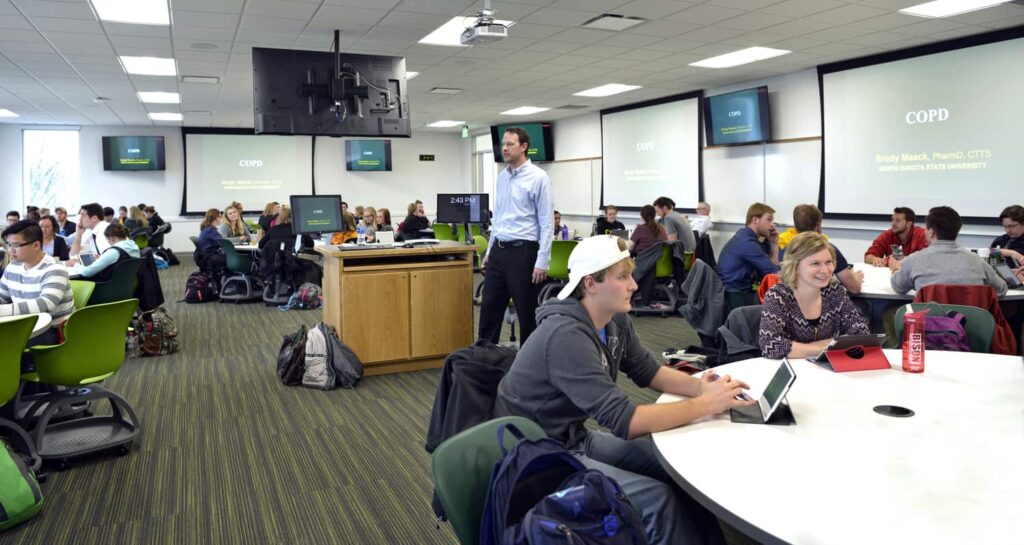On a recent tour of the newly opened A. Glenn Hill Center at North Dakota State University, a facility supporting science, technology, engineering and mathematics, it was striking to see the energy and activity in the classrooms. Contrary to the image of a professor standing at the front of the room delivering a lecture, students were clustered in groups throughout the room. Conversations were lively. And the professor was mobile, moving in between the clusters to engage as well as teach.
More than the future, the Hill Center represents where education is going today. Beyond an accommodating space for students to listen to a lecture, effective design is about creating a place that encourages collaboration, engagement, and better learning. Discovering that nexus means understanding the way students learn and instructors teach.
Student learning styles
The three most common learning styles are familiar to many of us and we can probably relate to one of styles described below. In reality, we all learn using a combination of these methods.
- Visual learners (65%) – It’s no surprise that most people like pictures when they learn. Diagrams, graphs, photos and gestures all appeal to this group.
- Auditory learners (30%) – Students in this category prefer verbal instruction, sound, music, etc. A great lecture with inspiring music will win this group over.
- Kinesthetic learners (5%) – This is the hands-on group of learners, which means they like role-playing, trying things out and doing an activity. (Bradford, 2011)
Even more important for creating a successful classroom design is to plan for how instructors teach because they determine the activities that actually happen in the classroom.
Higher education teaching styles
The most common pedagogy or ways instructors teach can be broken down into three categories as outlined on Teach.com. Classroom design should enhance all these teaching methods to provide the ideal learning environment.
- Direct instruction – In this teacher centered-approach, instructors use the lecture format to share their knowledge and expertise. This method can be very successful especially when teaching basic and fundamental skills.
- Inquiry-Based learning – Instructors teach by facilitating hands-on learning and student exploration when using this method. This is a student-centered approach which encourages learning through experiences like field observations and experiments.
- Cooperative learning – This is another student-centered approach which uses group learning activities such as debates and laboratory assignments. Students develop a strong sense of community and learn from their peers with this approach.
Active learning most successful
While it’s interesting to review all the teaching and learning styles, research shows student-centered education, which incorporates active learning, to be the most effective approach. In addition, the National Survey of Student Engagement (NSSE) published a study providing insights into some high-impact teaching practices. These practices have shown a positive association with student learning and retention. As we think about designing our classrooms, we proactively address these high-impact practices, while still keeping other styles in mind.

Classroom design characteristics
Classroom design does matter. Research supports the role of learning spaces as an important component alongside pedagogy and technology. With the wide variety of learning and teaching styles active in our colleges, classrooms need to be strategically designed with several emphasis areas to create an impactful learning environment.
- Flexibility – Classrooms should support multiple activities by instructors and accommodate different teachers throughout the day/week. They also need to support future pedagogical approaches. Classrooms need to enhance a variety of learning activities – such things as lectures, hands-on assignments, group activities, audio/visual presentations, and more. Often flexibility requires a large footprint for a classroom, moving chairs and or tables around during class takes a bit more space (25-30s.f./student).
- Comfort – One of the most important characteristics of a good classroom plan is to make sure it is designed for people of all sizes and as a place that feels comfortable. Comfort comes in many forms, but chairs, desks, lighting, daylighting, temperature all contribute to student comfort.
- Inspiration – It almost goes without saying, but students and teachers need a setting that inspires them to learn. Natural daylight, natural materials, and good design can be sources of inspiration.
- Collaboration – More than ever, designing a classroom that allows students and instructors to connect with each other is critical to success. Students learn better when they work together. Classrooms need to encourage cooperative learning by providing enough space for students to collaborate and giving them the tools to share their knowledge (make their thinking visible).
- Visible Thinking – Learning is a process. Students need to be able to demonstrate their knowledge to their peers and teachers. This allows instructors and fellow students to correct assumptions and help improve learning. Classrooms can make this visible through white boards and monitors for sharing content.
- Technology – All classrooms need to support the ubiquity of technology in a seamless, invisible way.
Student-centered design
Leveraging space as a tool in facilitating learning offers an opportunity to expand student and educator engagement. This means we need to break out of traditional design assumptions for how classrooms used to be viewed in higher education. Classrooms are no longer prescribed spaces to only serve one teaching style. As institutions strive to meet the changing needs of students and educators, they will benefit when they consider all learning and teaching styles along with strategic design features to help create the ideal student-centered classroom design.








